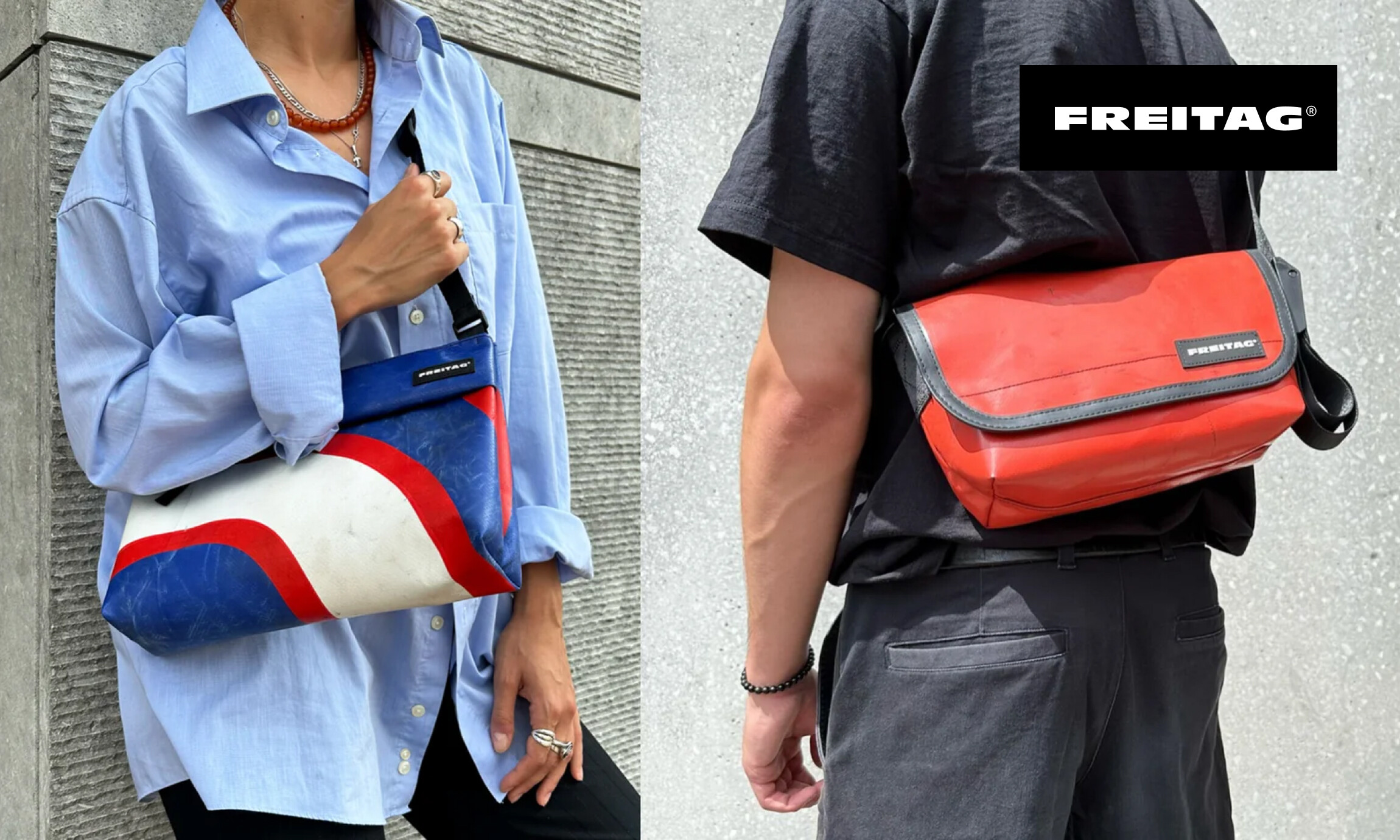
One of the pioneers in making the circular economy a commercial success, the bag and accessories brand FREITAG embraced composable technology to make its eCommerce experience as unique as its products. Read the testimonial from Fabio Calia, IT & Applications Lead Link, on the company’s journey to a more sustainable digital future.

At FREITAG, a visionary brand that makes bags and accessories from used and circular materials, thinking and acting in cycles has been part of our everyday lives for as long as we can remember.
It all started in Zurich, Switzerland, in 1993, when company founders Markus and Daniel Freitag created messenger bags made from discarded truck tarps. The two brothers, both graphic designers, were searching for a robust, water-repellent bag to hold their work. What they achieved went far beyond their initial goal: Today, FREITAG is a successful brand with 30 shops across Europe and Asia.
Our mission has been to live and breathe the circular economy, providing robust and functional bags and accessories for everyday use. Staying true to our ethos, we also offer repair and exchange services, so fan-favorite products already made to last are even more durable. This is made possible through modular design: Detachable pieces that, put together, expand the life cycles of our one-off products.
Every product that leaves the factory floor is one-of-a-kind. This is amazing for our customers and central to our brand, but presents operational challenges. While mass-market brands can photograph a product once and sell it thousands of times, at FREITAG, we have to capture a product image and describe each item individually. Every product listing must be manually added to our eCommerce platform — one by one. Running campaigns and promotions comes with the same complexity.
For many years, we relied on a monolithic eCommerce system that had to handle all data and use cases across the business. As product data became more varied and extensive, the system increasingly impacted website performance, leading to slow loading times and, in some cases, even outages. As we expanded our product portfolio to include items like airbags, mobile phone cases and services such as repairs and swaps, system downtime was also an issue, disrupting the customer experience.
Another reason we accelerated our search for an alternative eCommerce solution was the high maintenance costs of working with an external agency. While we were satisfied with the quality of their work, the many dependencies slowed down issue resolution. More importantly, agency-led development was expensive. We knew it was time to take ownership of our digital presence to gain flexibility, increase speed and reduce costs.
That’s when we decided to overhaul our eCommerce infrastructure and began the search for an enterprise-level eCommerce platform.
Why we chose composable commerce to sell upcycled products online
Composable commerce was already on our radar before we even began the vendor selection process. From the outset, we knew how challenging it would be to manage the uniqueness of our products with a standard platform like Shopify. While a templated solution might make for an easy start, it would quickly become limiting as our needs grew more complex.
Ultimately, we were looking for a flexible solution that would give us full ownership of our digital presence. Eliminating downtime was a top priority, and we also needed the ability to innovate continuously, because staying aligned with shifting customer behavior is essential for us.
After a thorough evaluation, we selected commercetools B2C Commerce and commercetools Frontend to power our eCommerce stack. The platform’s API-first architecture stood out: It allows fast data ingestion and dynamic product displays through API calls. Since the switch, we haven’t experienced a single website crash or outage.
commercetools also gave us out-of-the-box essentials like product catalog and checkout functionality, so we didn’t have to build everything from the ground up. That freed up our team to focus on what sets us apart, instead of just covering the basics.
By adopting modern tools from commercetools and AWS, we’ve gained the flexibility to easily integrate middleware services and accelerate feature releases that drive real business value. Our development process is now faster, more efficient and much more in our control.
Cost savings were another major benefit. Since moving to commercetools, we’ve cut maintenance costs by 20% — even after investing in our in-house development team and infrastructure. For FREITAG, that’s a meaningful win.
How we implemented commercetools — and what we learned from it
We chose a “big bang” approach for the implementation, keeping our legacy system running with minimal maintenance until the official cutover date. This allowed us to dedicate a focused development team to the new environment, free from the distractions of day-to-day operational issues. That focus made for a much smoother transition.
At the same time, we built a new team structure, clearly separating frontend and backend development. Adopting Scrum practices, daily standups, weekly planning sessions and a DevOps mindset helped us ensure end-to-end visibility, information flow and accountability across the board.
Getting buy-in from our business colleagues was straightforward. At FREITAG, we follow self-organizing principles and operate with a flat hierarchy, which fosters transparency and collaboration. Our marketers and other business partners are closely aligned with the development team, so their priorities and even wish-list items are taken into account during planning.
Of course, not everything went perfectly — and we learned valuable lessons along the way.
For one, we underestimated how long hiring and onboarding developers would take. In hindsight, hiring an additional backend developer during the migration would have helped mitigate some of the pressure.
We could have also spent more time upfront gathering business requirements. Things changed quickly, and we weren’t fully prepared for how dynamic those needs would become. Stronger communication and stakeholder management would have helped us stay ahead of that curve.
Another challenge came from SEO. We knew overhauling the website structure would impact search rankings, but we didn’t anticipate how significant the drop would be in the short term. With significant backend and frontend changes, our URL structure changed dramatically. For others planning a similar transformation, this is an area to prepare for more proactively.
That said, the things we got right have paid off in a big way. With full control of our eCommerce platform, our team can now focus on building features that deliver real business value — faster, more efficiently and within budget. Internalizing the development and introducing a new tech stack with commercetools empowered FREITAG to truly own our digital future.
Aligning composable with AI: What’s next for FREITAG
Our composable architecture is the foundation of a consistent flow of innovations, enabling us to deliver daily improvements to our customer experience. From making checkout workflow more intuitive to changing product hierarchy, our goal is to help our customers find unique products faster among a growing assortment.
Now, we’re taking things a step further with AI. Our team is developing AI-powered tools to help customers navigate our growing, ever-changing assortment. With each item being unique — and available in varying colors and styles — finding the right product can be a challenge. AI can help us surface the most relevant options at the right time, personalized to each shopper’s intent and context.
By combining the flexibility of composable commerce with AI, we’re not just enhancing the customer experience — we’re scaling the impact of circular design on new audiences around the world.
